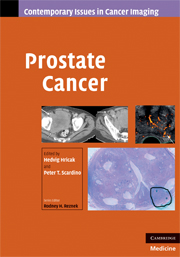Book contents
- Frontmatter
- Contents
- Contributors
- Series Foreword
- Preface
- 1 Anatomy of the prostate gland and surgical pathology of prostate cancer
- 2 The natural and treated history of prostate cancer
- 3 Current clinical issues in prostate cancer that can be addressed by imaging
- 4 Surgical treatment of prostate cancer
- 5 Radiation therapy
- 6 Systemic therapy
- 7 Transrectal ultrasound imaging of the prostate
- 8 Computed tomography imaging in patients with prostate cancer
- 9 Magnetic resonance imaging of prostate cancer
- 10 Magnetic resonance spectroscopic imaging and other emerging magnetic resonance techniques in prostate cancer
- 11 Nuclear medicine: diagnostic evaluation of metastatic disease
- 12 Imaging recurrent prostate cancer
- Index
- Plate section
- References
7 - Transrectal ultrasound imaging of the prostate
Published online by Cambridge University Press: 23 December 2009
- Frontmatter
- Contents
- Contributors
- Series Foreword
- Preface
- 1 Anatomy of the prostate gland and surgical pathology of prostate cancer
- 2 The natural and treated history of prostate cancer
- 3 Current clinical issues in prostate cancer that can be addressed by imaging
- 4 Surgical treatment of prostate cancer
- 5 Radiation therapy
- 6 Systemic therapy
- 7 Transrectal ultrasound imaging of the prostate
- 8 Computed tomography imaging in patients with prostate cancer
- 9 Magnetic resonance imaging of prostate cancer
- 10 Magnetic resonance spectroscopic imaging and other emerging magnetic resonance techniques in prostate cancer
- 11 Nuclear medicine: diagnostic evaluation of metastatic disease
- 12 Imaging recurrent prostate cancer
- Index
- Plate section
- References
Summary
Introduction
Over 186 000 men will be diagnosed with prostate cancer in 2008, accounting for approximately 25% of newly diagnosed cancers in the US male population [1]. In the era of prostate-specific antigen (PSA) screening, prostate cancer has undergone a significant downward stage and risk migration, with an increasing proportion of low-risk, organ-confined disease being diagnosed [2].
Transrectal ultrasound (TRUS) imaging of the prostate has played a fundamental role in the diagnosis, staging, and management of prostate cancer. During the past decade, technological innovations have improved the detection of prostate cancer. Clinical research continues to focus on methods to accurately and efficiently identify clinically significant neoplasms. In this chapter, we describe contemporary techniques for TRUS imaging and detection of prostate cancer.
Sonographic anatomy
Accurate evaluation and assessment of the prostate during TRUS requires a fundamental understanding of the underlying sonographic anatomy and histopathology of the gland. The prostate gland is anatomically divided into zones, originally described by McNeal in 1981 [3]. Zonal architecture of the prostate is defined anatomically with respect to glandular drainage into the prostatic urethra, and consists of a total of four glandular zones – the periurethral zone, the transition zone, the central zone, and the peripheral zone – as well as the anterior fibromuscular stroma. The anterior fibromuscular stroma does not contain any glands, whereas the peripheral zone comprises approximately 70% of the glandular tissue in the normal prostate.
- Type
- Chapter
- Information
- Prostate Cancer , pp. 102 - 119Publisher: Cambridge University PressPrint publication year: 2008



